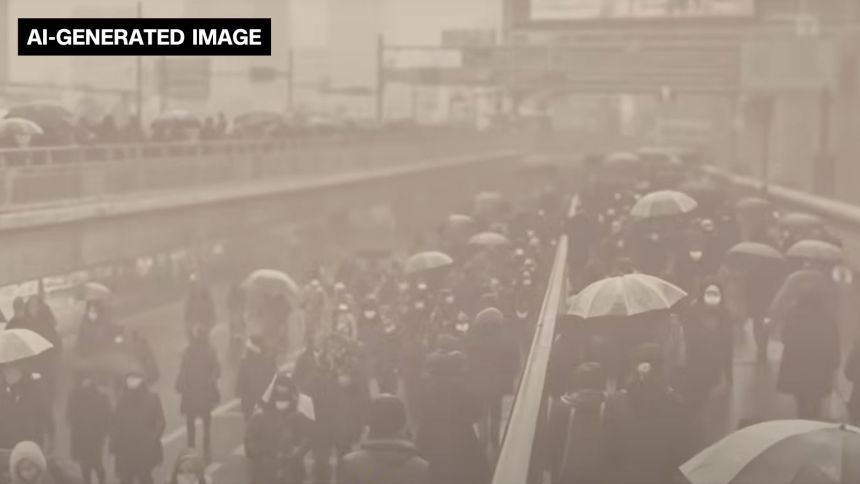Tweet
Email
Link
Tokyo
—
Large clouds of smoke billow from Japan’s most famous mountain.
In no time, volcanic ash spreads to the heavily populated capital of Tokyo, fogging up the air and blanketing buildings and vehicles.
This is all from an AI-generated video released by Japan’s government to warn Tokyo’s 20 million residents what to expect if Mount Fuji, the breathtakingly beautiful volcano that looms over their city, ever erupts.
While there is no suggestion that an eruption is imminent, Fuji is an active volcano. It last erupted 318 years ago, in what is known as the Hoei eruption.
The AI-video, released on Sunday by the Tokyo Metropolitan Government’s Disaster Prevention Division, shows a woman in a bustling street suddenly receiving a warning on her phone informing her the volcano has erupted.
“The moment may arrive without any warning,” says the narration, before the video cuts to dramatic visuals of large clouds of smoke emitting from Fuji.
The video warns that volcanic ash could reach Tokyo within two hours, causing health hazards as well as disruptions on to power supplies, traffic and food distribution.
The government’s cabinet office released a separate simulation video Tuesday – Japan’s Volcano Disaster Prevention Day – urging people to “visualize specific scenarios” so that they could be better prepared.
Japan is no stranger to severe earthquakes and volcanoes. It lies on the Ring of Fire, an area of intense seismic and volcanic activity on both sides of the Pacific Ocean.
Authorities have stepped up their cautionary tone in the past year in the hope of raising citizens’ alertness levels.
Fears of a “big one” have been mounting since the Japanese government warned in January that there was an 80% chance of a severe earthquake hitting the country’s southern Nankai Trough within 30 years. Some seismologists have been critical of these warnings, questioning whether they can ever be accurate.
Some residents expressed worries following the Fuji video.
“The thought of volcanic ash causing transportation chaos in the Tokyo metropolitan area is terrifying,” said an internet user identified as Mayotan on X.
Another X user identifying himself as Suu noted both the importance and challenges in getting prepared. “Cassette stove, flashlight, water, food.” But, they noted it “would be hard” to have the power go out in the summer, when temperatures in Japan soar to sweltering levels.
Some viewed the Japanese authorities’ approach as alarmist, with well-intended warnings turning into deterrents for some tourists in the past few months.
“It tends to be used to stir up a sense of crisis and fear,” wrote user with X handle shomin_consul.
This is not the first time authorities have reminded resident in cities around Fuji to be prepared. In March, the government issued guidelines recommending residents maintain a two-week supply of essentials in the event of a full-blow spill.

A large-scale eruption would produce an estimated 1.7 billion cubic meters (60 billion cubic feet) of volcanic ash, the government said, of which around 490 million cubic meters is expected to accumulate on roads, buildings, and other land areas, requiring disposal.
Piled-up ash could cause wooden houses with low loadbearing capacity to collapse, one expert previously warned.
The sky would be covered in black volcanic ash, and urban areas would be plunged into darkness, even during the day, the government added.
The economic loss from a Mount Fuji eruption is estimated to be up to 2.5 trillion yen ($16.6 billion).
Even a small amount of accumulated volcanic ash could stop trains from running, and if it rains, ash that accumulates to a depth of more than 3 centimeters (1.2 inches) could make roads impassable for vehicles.
Logistics would be disrupted, making it difficult to obtain essential goods, and power lines could be cut by the weight of the ash, leading to power outages.

